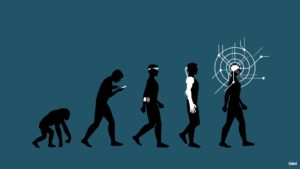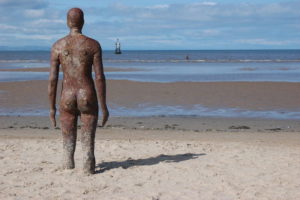
A number of scholars of post-humanity (such as Hayles and Wolfe) have argued that transhumanism is an unduly optimistic extension of humanism. I can’t agree – not only is it not optimistic, it is not a humanism. Transhumanism is filled with the anxiety of extinction. It also is enthused enough about non-human flourishing that it marks a departure from humanism (besides: is anything more optimistic than humanism in its enlightenment mode?). Transhumanism’s posthumanist stance is the continuation of enlightenment technoscience in so far as it centralizes human technology, even if it projects the technoscientific breakdown of humanity. However, insofar as its ideas and projected technologies propose an almost panpsychic collapse of mind and matter, it pushes us beyond reductive materialist, secular and humanist arrangements, and points to some interesting new openings.
One way to go about thinking through all this is to consider, as Bialecki and Lowrie have suggested, the figure of anthropos. The human is, as Foucault pointed out, an image built through a series of disciplines (biology, economics, linguistics) that came together in the space of non-transcendental knowledge to capture human activity (life, labor, language). The figure under which that image has been organized is anthropos, combining modern science and humanism in an often fraught relationship.

The humanism at stake, the humanism built around anthropos, is more precisely secular humanism – just as the science is secular science. In humanism, anthropos is the figure that is to be discovered and known as humans take over their own destiny from the realm of accidents, pre-ordained trajectories, demons and gods. The takeover comes with two supplanting and explicitly secular temporalities: historicity and futurity, humans knowing their past as of their own making, and making their future through their own knowing. In other words, as Foucault laid it out, humans are those odd creatures who get to know themselves as finite, knowable beings, knowable just as nature itself can be known, complete with greco-latin terms branching off of a genealogical tree (homo), as with everything else in the scientific taxonomy. And in getting to know themselves, they create an object about which there is a growing body of knowledge that can eventually become complete, thereby helping the creature’s movement forward into time. Except, of course, it can’t. The outline of what humans know about themselves, how humanity as a whole becomes characterized through the sciences and humanities, how it sees itself and gives itself meaning, makes up anthropos; but anthropos is an insatiable figure, sucking in the vast bodies of knowledge and meaning, all the –ologies (from biology to mythology), without ever fully filling up. The finitude of knowledge and hence the limits of self-knowledge, of the human condition as a whole has been a major source of energy for western metaphysical acrobatics, trying to figure out its own limits or transcending beyond them.
Tragic Humanisms

Temporally, secular humanism was always future-oriented, insofar as its utopian project was to plan the human future properly, in accord not with divine will but with free and proper human reason and knowledge. Science has played a big role in this utopianism. Alongside humanism, it conceived of the future as the fulfillment of potentials or essential attributes of the human, to make anthropos and human coextensive. After the enlightenment, to live well did not mean an individual ethical or philosophical project, as it had done for the greeks and medievalists all the way up to Montaigne’s Know Thyself; living well became a social project (e.g. with Kant, “know thyself” becomes “dare to know,” that is, an imperative to question the social conditions of knowledge). The goal was to arrange for a society that would allow all humanity to fulfill its real true potential, beyond toil and suffering, beyond all that had marked its past so far, lost as it was in the haze of primitivism, religion and superstition. Science was key here. he scientific project is usually described, via Bacon and Descartes, as one whose goal was mastery over nature. What is left out of this picture, though it is explicit in Condorcet and Comte among others, is mastery over the social and mastery over the human, which in the materialist non-dualistic schema was implied already in the “mastery over nature” part. To arrange the right sort of society, to foster humanity’s flourishing in the most efficient and rational way, you had to map the desires, motives, the real empirical animating force of anthropos, not its theological soul, not its childish dependence on religion, not its ritualized appearances as replicable social archetypes or roles without interiority. All the questions of political philosophy and economics (including Marx’s) needed to or tried to establish the inner nature of anthropos as a way to then outline how to bring about human flourishing.
A range of different intellectual projects have questioned the stability of that anthropos as a fixed figure whose perfection can be aimed for, whose apparent will and freedom can be made calculable. One of these is the post-secular (rather than post-human) critique of secular humanism, which focuses on the finite knowability assumed in the social sciences and social projects with regards to human flourishing. For Charles Taylor, for example, the hide-bound self of a knowable anthropos measured through the calculus of the body (because what else is there?) is the pathway to instrumentalized, parochial, reductive concerns. Humans require, and are deserving of, much higher forms of flourishing. But foregrounding human flourishing is to beg the question. Why human flourishing? Or flourishing at all? Who said? Despite its appeal to a transcendent or otherworldly order that can elevate the human, a spiritually-inclined humanism kindly reinscribes the cosmic anthropocentrism of secular humanism in non-secular terms, and gets to re-present not only humans but the cosmos in which humans have co-evolved as a teleological one, the assumed goal being human flourishing in some ill-defined way that precludes a materialist calculus. This is progress as a spiritual rather than material trajectory.
Pushed to its logical end, as it is by transhumanists like Ben Goertzel and Nick Bostrom, transhumanism jettisons anthropos because it no longer sees human flourishing as the central concern of humans or more importantly of the cosmos in which humans have evolved. If there is potential – and potential is a term used frequently by transhumanists – it is not a potential slouching towards the perfection of a human essence or capacity. Human potential is pressed into service for beyond-human or trans-human unfoldings – crucial for Bostrom, for example, is “the potential of humankind to develop into posthumanity,” such that if the development of post-human intelligent life is thwarted, it would count as a catastrophic event. That is what makes transhumanism more interesting than just a happy roboticist having a dry dream or an athlete seeking better performance.

Unlike the solipsistic loneliness of anthropos in modernity – a being who is unique in the universe, whose consciousness is private, who is aware both of its own awareness and aware of its own pending death, who is godlessly in possession of its self and its world, who has emerged from the animal only to look around bewildered and keep asking, “What? Why? How? Who? Me?” – the transhumanist vision of the future of humanity sublates anthropos’ bounded inaccessible mind and proposes that humans cede the way to higher forms of intelligence and complexity: for that, indeed, is the telos of the universe. Whereas much of the new materialist and new animist literature focuses on the distinction between life and non-life, the crucial radical division to contend with here is between mind and non-mind, mind and matter, and there most humanists won’t tread, as they fear the whiff of religiosity wafting out of any matter that’s got a mind of its own. But for transhumanists, consciousness, reason, mind are not the exclusive attributes of humans, even if in the transhuman cosmos they get translated into other names: information, pattern, complexity, computation, algorithmic processing. The universe computes, so information develops from simple to complex patterns, the most complex thus far being the pattern known in general as the human mind. Only thus far. There’s still some way for the cosmos to go. Not a will to live or a will to power but a will to complexity rules this cosmology and the implied question would not be how the cosmos thinks (as per that posed by Eduardo Kohn regarding forests) but how thought might be cosmic.
The development of machine intelligence by humans is part of this story of evolution. And here, at the very apex of human mastery and achievement, the human produces its own obsolescence – or, more likely, extinction. That is actually its very purpose, the anthropic destiny. In this sense, it can be read by secular humanists as the perfect tragedy; overcome by the ambition of mastery, drunk with fantasies of the limitless, the protagonists are the agents of their own demise, heading to a fall of their own making despite all the warning signs. Indeed, that’s just how it has been parsed: transhumanists have been readily charged with hubris, the ultimate tragic quality.
Extinction and the View from Nowhere

But that sort of attitude towards transhumanism is inadequate to the current moment. Because the moment is both imbued with radical transformation and overtaken by extinction – for humanists as well as transhumanists. Although transhumanists are pegged as optimists, it is striking how preoccupied they are with pessimistic endings and catastrophic scenarios: see, for example, the Lifeboat Foundation or Bostrom’s various takes on “Existential Risk: Human Extinction Scenarios and related Hazards.” Using Bostrom’s own term and to avoid the religiosity connected to “end-times,” I bundle all these as extinction scenarios. Extinction is an expiration or ending of a sort that erases the possibility of tragedy, that is, the possibility of looking back and deriving meaning from it.
Tragic meaning has been one of the secular humanist trump cards. Having eliminated fate, destiny, and the afterlife, and made death final, secular humanism has had no option but to make death the very condition of a meaningful life, pulling out of the hat of meaningless death – a hat sewn by its own milliners – the rabbit of meaning, through tropes like the tragic or the human condition, in which the lesson is that even as human powers attain king-like or god-like levels, it is still mere mortal and fallible humans who have to exercise their freedom in choosing between good and evil. Indeed, that’s been the other grounds on which many ethicists have attacked immortalist projects undertaken by transhumanists: now that it seems in the realm of possibility, they say, the age old human dream of immortality should not be attempted because getting rid of death would change the human condition, and we would not be able to find meaning in life any more. If I think that sort of criticism is hooey, it is not because I want to advocate for immortality or a limitless future. It is because I think it is hooey. It is no less of a fairytale than the fairytale of eternal life. The tragic as a trope is a tale for secular humanist adults who cannot appeal to the immaterial, but do not want to slide down the nihilist rabbit hole either; so the hole becomes a magician’s hat, the last refuge of the humanist where death is magically transformed into the meaning of life.
However, the same trick can’t be performed with extinction. Anthropocenic or singularitarian, by gaia or by robot, by nuclear detonation, asteroid collision or heat death, extinction is where human and anthropos – the species and the image it has of itself – finally become isomorphic in collapse, dissolving into nothingness. Extinction has haunted modernity and its humanist story of progress throughout – via the absurdity of individual death, but also through the specter of larger forces like entropy, evolutionary obsolescence, nuclear holocaust, civilizational collapse and other “bad endings,” to use Susan Harding and Kathleen Stewart’s term. As I’ve written before, endings in the secular are already built into all futures, all futures already entombed. This is the other neglected part of Weber’s disenchantment essay, in which deaths haunt the on-going achievements of human beings. But taking an idea laid down by the philosopher Ray Brassier (also see Eugene Thacker), I would say that more than just the ghost haunting the secular humanist future, extinction is the transcendent figure through which activity and knowledge are being understood and organized, through which the somersaults, pirouettes and turns in western metaphysical gaps are being carried out (see, for example, the ontological turn, the Anthropocene, or Elizabeth Povinelli’s geontopower). But the unique thing about extinction as the transcendent ground of self-understanding is that it is not only an understanding beyond the human, but also an understanding that undermines any possible meaning with respect to present activity or imagined future. Extinction undermines any possibility of humanist meaningfulness; there cannot even be an appeal to the tragic. Secular finitude reaches its logical end in extinction: humanity will disappear and then, as Nietzsche says, “nothing will have happened.” All of this desire, motivation, struggle, philosophizing, all this turning about for nothing. To ask the question in the present, “what is it all for?”, may produce some partially satisfying answer regarding the value of existence now (“You want to live!” Or “for a better future!” Or “to get this great project done”), but in the past tense, from the vantage of planetary annihilation (“What was it all for?”), there can be no answers. Indeed, there can be no question. The real view from nowhere is the view from extinction.
Openings

Is there any other view possible, a view from elsewhere? Maybe. It requires a combination of radical attitudes, such as proposed by some transhumanists, but also scientists and thinkers such as Lynn Margulis and Isabelle Stengers, who position themselves right in the swirl of larger and very dynamic forces – not in the mode of optimism, but nevertheless with a kind of exuberance with regards to those larger powers that constitute us. That is in part what I mean by “attitude,” similar to how Foucault used it to characterize “critique” as a modern attitude: striking a stance in relation to being and to received knowledge, producing a series of dispositions, developing epistemological and legal frameworks (such as those surrounding the Whanganui River in New Zealand), concepts, practices (like Natasha Myers’) that create strong and true relationships beyond the human. Easier said than done, and the transhumanist fetishisation of machine intelligence, nanotechnology, algorithmic rationality, neuroscience, bioengineering, space odysseys, the NBIC convergence, etc., to the detriment of openings to other forms of being, relating, thinking, acting and expanding (i.e. animistic, shamanic, thermodynamic, energetic, linguistic, vegetal) may not be the best way. In its current formations, it tends to reinscribe technology not as possibility but as power – and not just human power in general, but even narrower: technolibertarian Silicon Valley power. Nevertheless, the conceptual and practical possibilities opened up by some Nano Bio Info & Cogno technologies, their imaginaries, and transhumanist attitudes shouldn’t be discarded either. The implications of genetic engineering and brain implants for the relationship between anthropos and its cosmic context are very deep and pretty astounding – Goertzel, for instance, acknowledges this, writing that the new technologies are “as much about mind and reality as they are about AI algorithms” – which is not to suggest that the cosmos is anthropic, but rather that anthropos may be cosmic. Not transhumanist in the super-cyborg fashion, the posthuman future requires an attitude and an understanding of technology that can transform discrete, epidermally-contained, self-important identities into shifting and relational patterns in a complex continuum of consciousness extending from plant to implant to the planetary.
By Abou Farman


https://waterfallmagazine.com
Right here is the perfect blog for everyone who really wants to find out about
this topic. You know a whole lot its almost tough to argue with you
(not that I personally will need to…HaHa). You certainly put a fresh spin on a topic that’s been discussed for ages.
Excellent stuff, just wonderful!